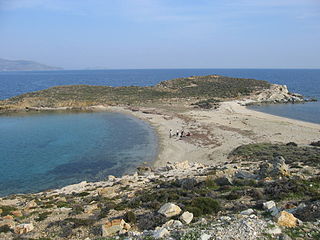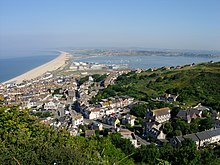Tombolo

A tombolo, from the Italian tombolo, derived from the Latin tumulus, meaning 'mound,' and sometimes translated as ayre (Old Norse eyrr, meaning 'gravel beach'), is a deposition landform in which an island is attached to the mainland by a narrow piece of land such as a spit or bar. Once attached, the island is then known as a tied island. Several islands tied together by bars which rise above the water level are called a tombolo cluster.[1] Two tombolos can form an enclosure (called a lagoon) that can eventually fill with sediment. Tombolos may be considered a type of isthmus.
Formation
Wave refraction




"True" tombolos are formed by wave refraction. As waves near an island, they are slowed by the shallow water surrounding it. These waves then refract or “bend” around the island to the opposite side as they approach. The wave pattern created by this water movement causes a convergence of longshore drifting on the opposite side of the island. The beach sediments that are moving by lateral transport on the lee side of the island will accumulate there, conforming to the shape of the wave pattern. In other words, the waves sweep sediment together from both sides. Eventually, when enough sediment has built up, the beach shoreline, known as a spit, will connect with an island and form a tombolo.[2]
Lateral longshore drift
In the case of Chesil Beach or Spurn Head, the flow of material is along the coast in a movement which is not determined by the now tied island, such as Portland, which it has reached. In this and similar cases, whilst the strip of beach material connected to the island may be technically called a tombolo because it links the island to the land, it is better thought of in terms of its formation- as a spit or otherwise.==Formation==
List of notable tombolos
- The Angel Road of Shodo Island, Japan
- Aupouri Peninsula, New Zealand
- Ayre o Swinister, Shetland Islands, Scotland
- Barrenjoey Headland, Pittwater, New South Wales, Australia
- Beavertail Point, Conanicut Island, Rhode Island
- Biddeford Pool, Maine [3]
- Cádiz, Andalucía, Spain
- Chappaquiddick Island, Martha's Vineyard, Massachusetts
- Charles Island, Connecticut
- Chesil Beach, Dorset, England
- Cheung Chau, Hong Kong
- Fingal Bay, New South Wales, Australia
- The Rock of Gibraltar
- Grand Island National Recreation Area, Michigan, Lake Superior
- Gwadar, Pakistan
- Hakodate, Hokkaido, Japan
- Howth Head, Dublin, Ireland
- Inishkeel Island, Narin, Ireland
- The isthmus at Aden, Yemen
- Kapıdağ Peninsula, Balıkesir, Turkey
- Kettla Ness, Burra, Shetland Islands, Scotland
- Kurnell, Sydney, New South Wales, Australia
- Langness, Castletown Bay, Isle of Man
- Las Palmas de Gran Canaria, Canary Islands, Spain
- Llandudno, Wales
- Louds Island at Muscongus Bay, Maine
- Maharees, Dingle Peninsula, Ireland
- Mare Island, Vallejo, California
- Mersey Point, Shoalwater, Western Australia
- Miquelon, Saint-Pierre and Miquelon, France
- Monemvasia, Laconia, Peloponnese, Greece
- Monte Argentario, Tuscany, Italy
- Mount Maunganui, New Zealand
- Mount Taipingot, Rota, Northern Marianas
- Nahant, Massachusetts (a natural tombolo, but connected to the mainland by a causeway)
- Palisadoes, Kingston, Jamaica
- Presqu'ile Provincial Park, Ontario, Canada
- Presqu'ile de Giens, Hyères, France
- Quiberon, France
- Sainte-Marie, Martinique, France
- Sharp Island, Sai Kung, Hong Kong
- St Ninian's Isle, Shetland Islands, Scotland
- Scotts Head, Dominica
- Taylor's Island, Shelter Island, New York
- Yei of Huney, Huney, Shetland Islands, Scotland
- Nissi beach, Ayia Napa, Cyprus
See also
References
- ^ Glossary of Geology and Related Sciences. The American Geological Institute, 1957
- ^ Easterbrook, Don T. Surface Processes and Landforms, Second Edition. 1999 Prentice Hall Inc.
- ^ Neal, William (2007). Atlantic Coast Beaches: A Guide to Ripples, Dunes, and Other Natural Features of the Seashore. Missoula, MT: Mountain Press Publishing Company. p. 272. ISBN 0-87842-534-9.
{{cite book}}: Unknown parameter|coauthors=ignored (|author=suggested) (help)
External links
- Geology.About.com's page on tombolos (useful for its descriptive photograph)


